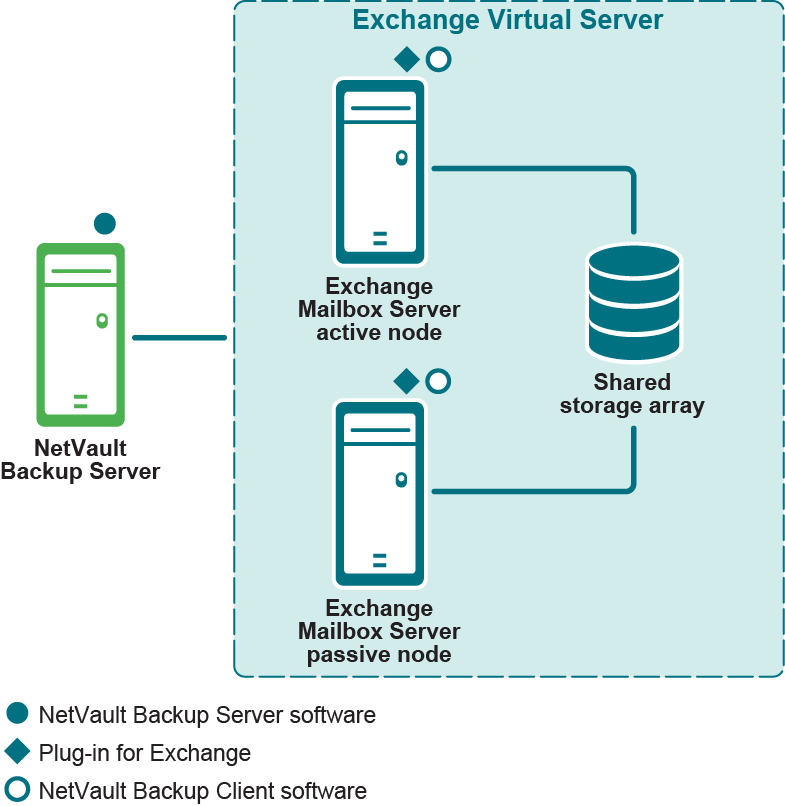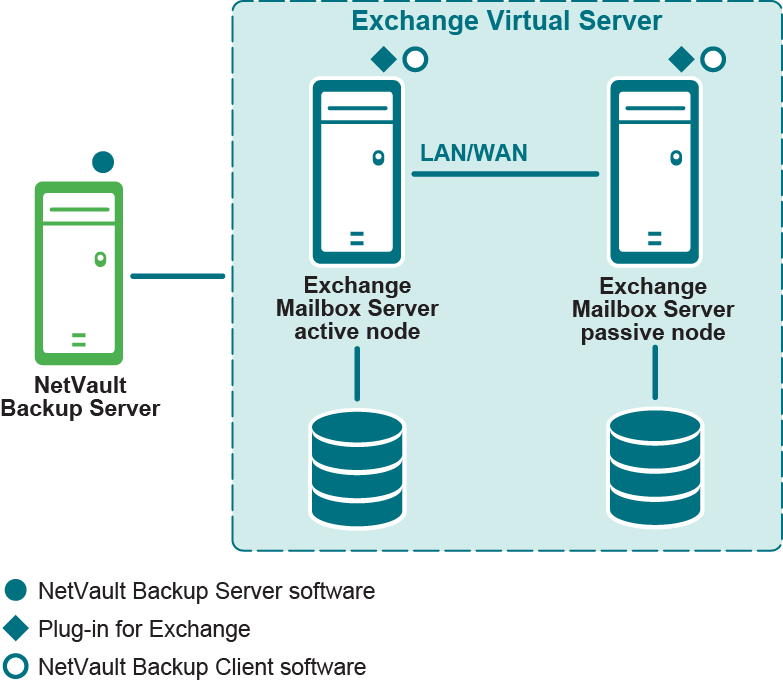Single Copy Cluster (SCC) or Failover Cluster
|
• |
Supported Exchange Server Versions: Exchange 2007 only |
|
• |
Supported Exchange Server Editions: Enterprise only |
|
• |
Supported Backup Methods: ESE and VSS |
|
• |
Plug‑in for Exchange License Required: Plug‑in for Exchange Enterprise Edition Cluster Support |
SCC or Failover Cluster is a clustered solution that uses a single copy of a Storage Group on storage that is shared between the nodes in the cluster. In an SCC deployment, the Plug‑in for Exchange is aware of which node is the active node and performs backups of the Active Copy of the Storage Groups. During the restore process, data is restored to the active node. For more information regarding Exchange 2007 SCCs, see Single Copy Clusters at: http://technet.microsoft.com/en-us/library/bb125217.aspx.
In an SCC deployment, the plug-in is installed on the Exchange Virtual Server. The Exchange Virtual Server is a group of nodes and hosts that make up the cluster. The NetVault Backup Server sees the cluster as a single client, which is called a Virtual Client. When installing the Plug‑in for Exchange on the Virtual Server, the plug-in is installed on all nodes by using NetVault Backup’s Cluster Support. NetVault Backup’s Virtual Client is used to back up a single clustered resource, which in this example is the Exchange Virtual Server.
Cluster Continuous Replication (CCR)
|
• |
Supported Exchange Server Versions: 2007 only |
|
• |
Supported Exchange Server Editions: Enterprise only |
|
• |
Supported Backup Methods: ESE (Active Copy only) and VSS (Active or Passive Copy) |
|
• |
Plug‑in for Exchange License Required: Plug‑in for Exchange Enterprise Edition Cluster Support |
CCR is a clustered solution that uses built-in asynchronous log shipping technology to create and maintain a copy of each Storage Group on a second server in a failover cluster. CCR is either a one or two data-center solution, providing both high availability and site resilience. According to Microsoft, CCR uses the database failure recovery functionality in Exchange 2007 to enable the continuous and asynchronous updating of a second copy of a database with the changes that have been made to the active copy. During installation of the passive node in a CCR environment, each Storage Group and its database is copied from the active node to the passive node. This operation is called seeding, and it provides a baseline of the database for replication. After the initial seeding is performed, log copying and replay are performed continuously. For more information, see Cluster Continuous Replication at http://technet.microsoft.com/en-us/library/bb124521.aspx.
In a CCR deployment, the plug-in is installed on the Exchange Virtual Server. The Exchange Virtual Server is a group of nodes and hosts that make up the cluster. The NetVault Backup Server sees the cluster as a single client, which is called a Virtual Client. When installing the Plug‑in for Exchange on the Virtual Server, the plug-in is installed on all nodes by using NetVault Backup’s Cluster Support. NetVault Backup’s Virtual Client is used to back up either the Active or Passive node, which in this example is the Exchange Virtual Server.


